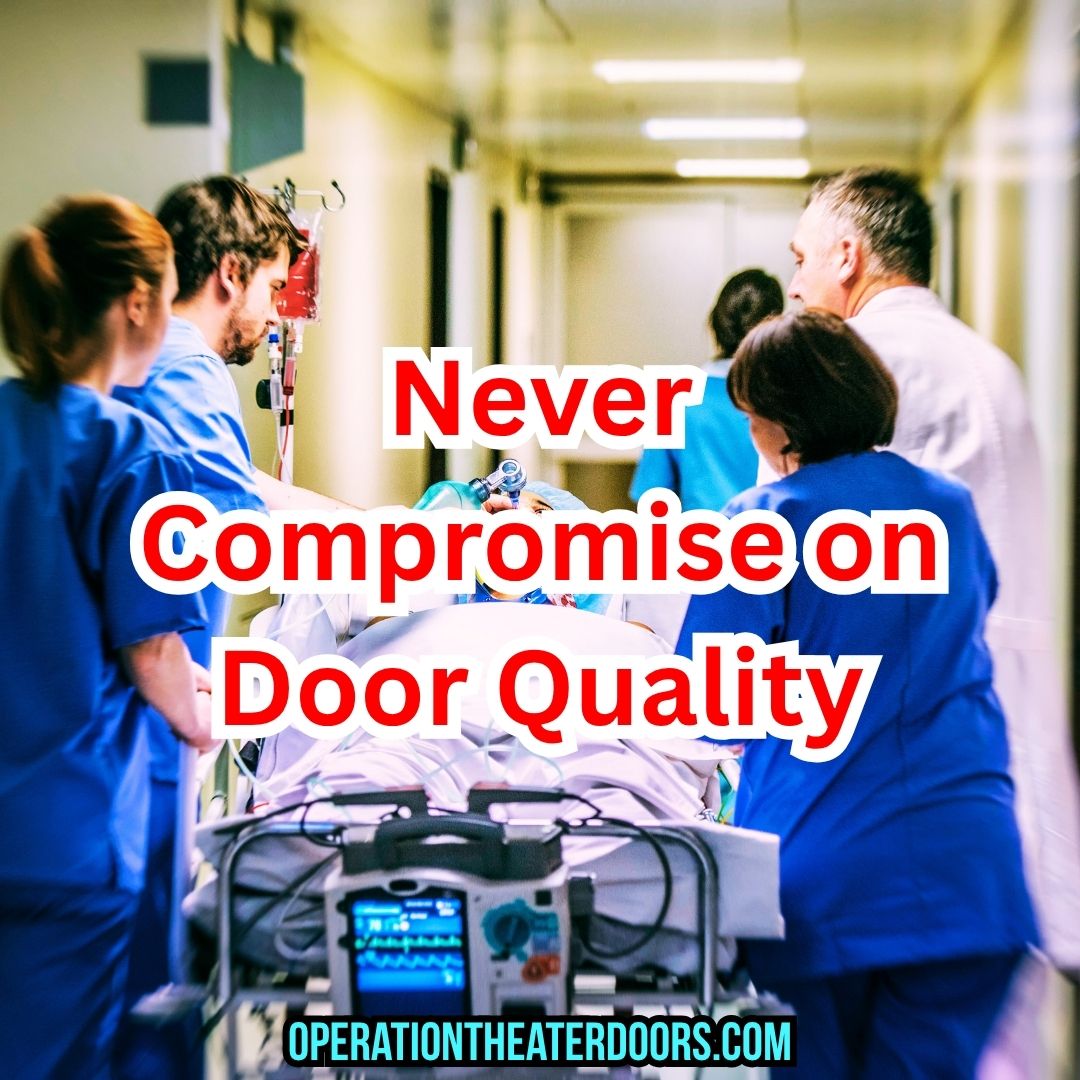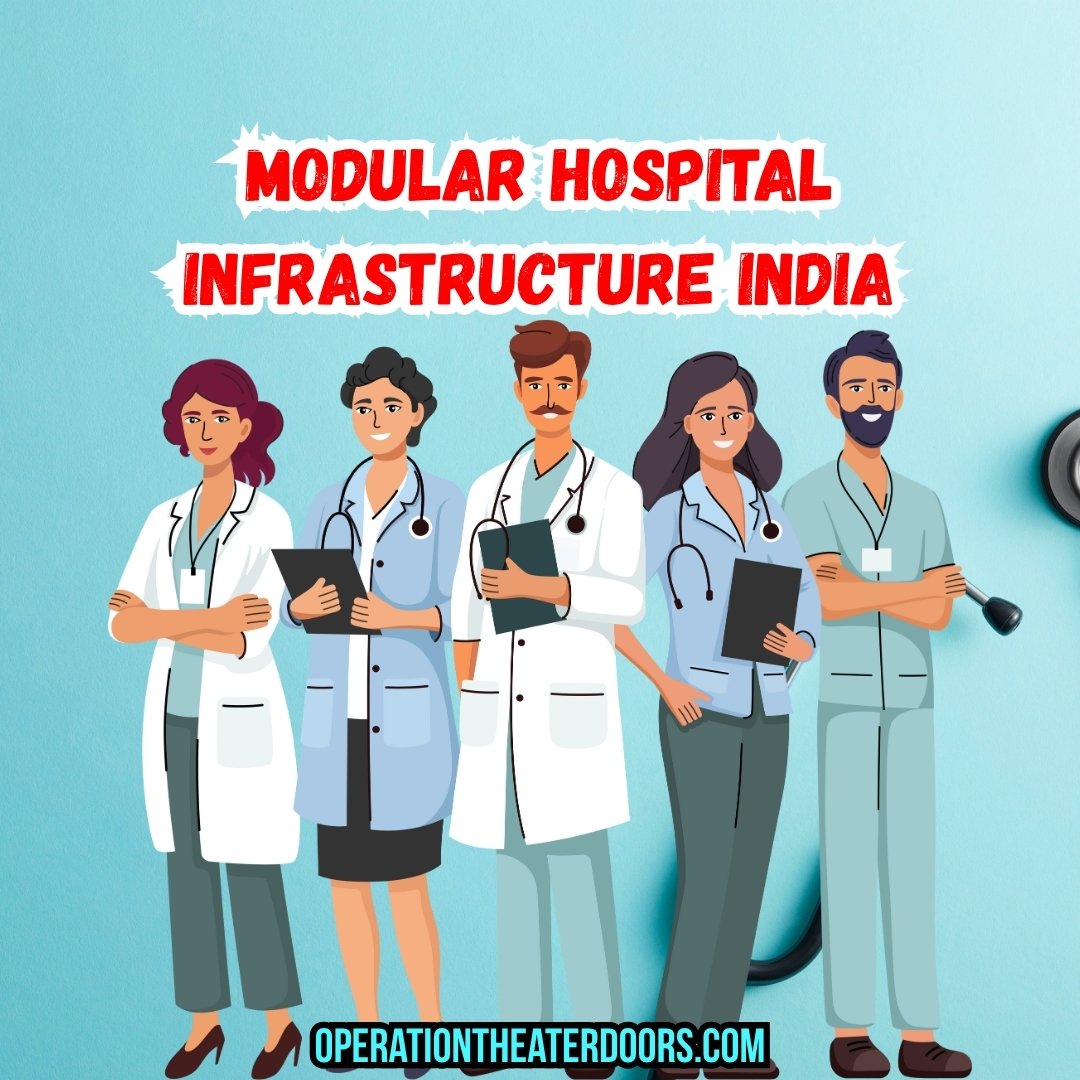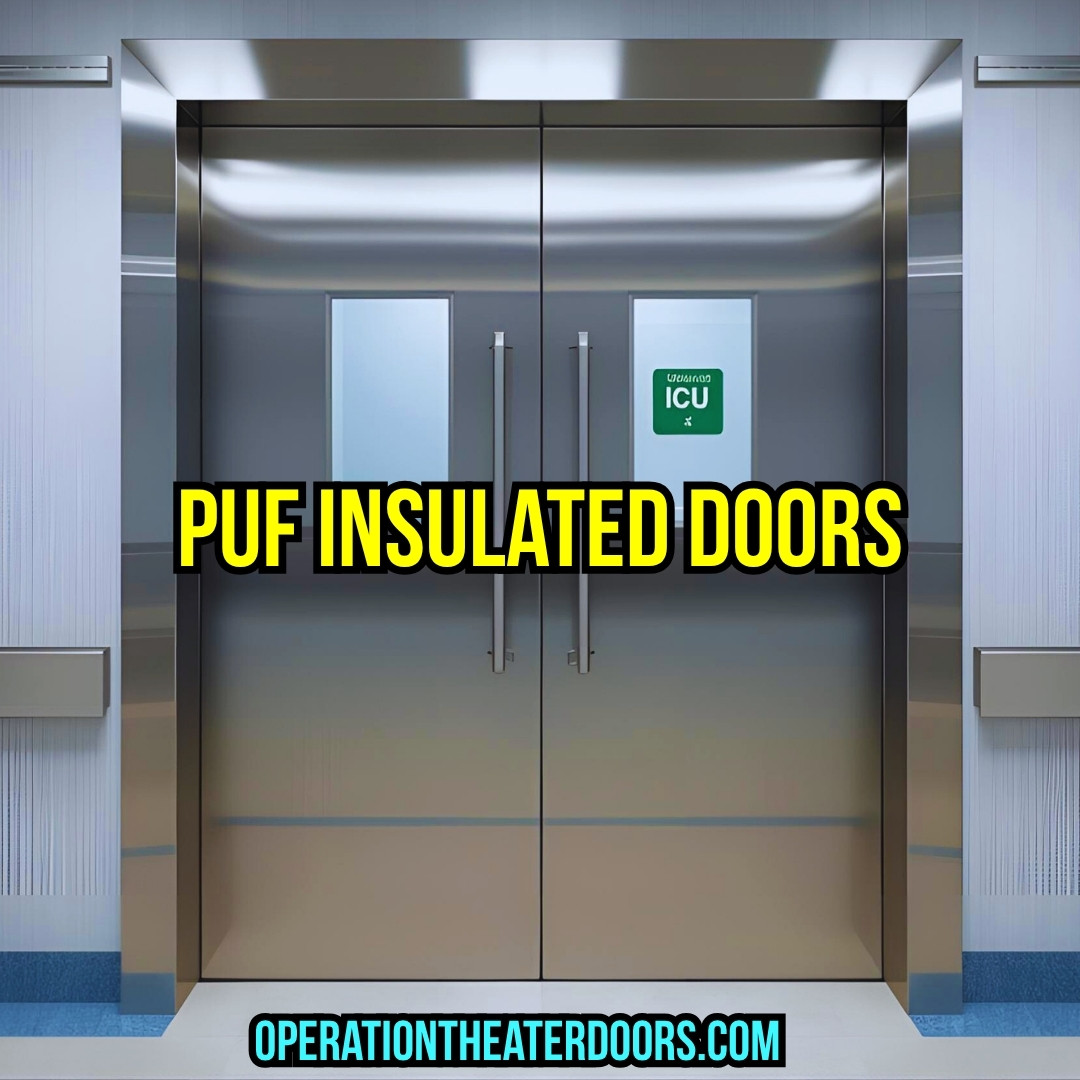
Hospital doors aren’t just barriers; they’re the first line of defence in controlled environments like ICUs and OTs. In Gujarat’s humid climate, where dust and microbes thrive, a subpar hospital door can compromise air quality, leading to HAIs that cost Indian hospitals billions yearly. For hospital administrators and architects in Ahmedabad, selecting doors that align with turnkey healthcare solutions means integrating them seamlessly into modular OT setups or ICU configurations.
The Critical Functions of ICU Doors in Patient Recovery
ICU doors play a pivotal role in maintaining isolation and accessibility. High-quality ICU doors feature hermetic sealing to prevent air leakage, ensuring positive pressure rooms stay contaminant-free. Think of it like a fortress gate: it must open smoothly for quick staff access yet seal tightly to block pathogens.
Key functions include:
- Thermal Regulation: In Ahmedabad’s hot summers, ICU doors with insulation maintain 22-24°C, vital for ventilator-dependent patients.
- Noise Reduction: Acoustic panels reduce external sounds by up to 40 dB, promoting restful recovery.
- Easy Mobility: Wide clearances (at least 1.2m) allow gurneys and equipment to pass without hassle.
From my experience setting up ICUs in Gujarat hospitals, opting for automatic ICU doors with touchless sensors cuts cross-contamination by 30%. For deeper insights, explore our ICU Doors page.
Why Operation Theater Doors Demand Precision Engineering
Operation theater doors, or OT doors, are the heartbeat of surgical suites. In modular operation theatres, these doors must withstand frequent use while upholding sterility. A standard OT door in India handles 50-100 openings daily, so durability is key.
Essential roles:
- Airtight Integrity: Prevents microbial ingress during surgeries lasting 4-6 hours.
- Quick Access: Sliding or swing mechanisms ensure surgeons enter without breaking sterile fields.
- Integration with HVAC: Doors link to HEPA filtration systems for laminar airflow.
I’ve consulted on turnkey projects in Ahmedabad where flawed OT doors led to NABH audit failures. Reliable operation theater door manufacturers prioritise flush designs to avoid dust traps. Check our Operation Theatre Doors for compliant options.
In both ICU and OT settings, these doors contribute to 20-25% better infection control rates, per WHO benchmarks.
Essential Materials for Durable and Hygienic Hospital Doors
Choosing materials for hospital doors is like selecting the foundation for a building—get it wrong, and everything crumbles. In India’s diverse climates, from Gujarat’s coastal humidity to inland dryness, materials must resist corrosion, harbour no bacteria, and comply with GMP for pharma doors and cleanroom flush doors.
PUF Insulated Doors: The Gold Standard for Thermal Efficiency
PUF insulated doors, with their polyurethane foam (PUF) core sandwiched between galvanised steel sheets, excel in operation theatres and ICUs. The 40-50mm thick PUF panel provides R-values up to 5.5, minimising heat transfer and energy costs by 25-30% in modular setups.
Advantages in practice:
- Superior Insulation: Maintains sterile temps without constant HVAC strain—crucial for Ahmedabad’s 45°C peaks.
- Lightweight Yet Strong: At 30-35 kg/m², they’re easy to install in turnkey projects.
- Moisture Resistance: Closed-cell foam prevents mould, ideal for cleanroom doors.
In one Gujarat hospital project I oversaw, PUF insulated doors reduced cooling bills by 15%. As a manufacturer of PUF panel doors, we ensure seamless integration. Learn more on our PUF Insulated Doors section.
Cleanroom Flush Doors and Pharma Doors: Prioritising Non-Porous Surfaces
Cleanroom doors demand flush, seamless surfaces to avoid particle accumulation. Materials like HPL-laminated MDF or stainless steel (Grade 304) ensure wipeability and chemical resistance for disinfectants.
Breakdown of ideal materials:
- High-Pressure Laminate (HPL): Anti-microbial coating kills 99.9% of bacteria.
- Stainless Steel: Corrosion-proof for pharma doors in diagnostics labs.
- PVC/GI Sheets: Cost-effective for F&B cleanrooms, with zero VOC emissions.
Comparisons show stainless steel cleanroom doors last 15-20 years versus 10 for wood-based ones. For Gujarat’s electronics and cosmetics industries, these doors meet ISO 14644 standards. Visit Cleanroom Doors for tailored solutions.
External reference: NABH guidelines emphasise non-porous materials for infection-prone areas NABH Standards.
Design Features That Enhance Safety and Efficiency
Design isn’t just aesthetics—it’s about functionality in high-stakes environments. For contractors in Ahmedabad handling fire exit doors or hermetic doors, thoughtful design means fewer callbacks and happier clients.
Hermetic and Sliding Designs for Seamless Workflow
Hermetic doors create an airtight seal via inflatable gaskets, essential for ICU doors and OT doors. In cleanrooms, they maintain ISO Class 5-7 air quality.
Design highlights:
- Inflatable Seals: Activate on closure, achieving 99% airtightness.
- Sliding Mechanisms: Space-saving for modular OTs, with low-friction tracks for silent operation.
- Breakout Features: Emergency swing-out for quick evacuation.
In turnkey healthcare solutions, these reduce door cycles from 10 seconds to 3, boosting efficiency. I’ve seen hermetic doors prevent 40% of airborne contaminations in Gujarat ICUs.
Fire Exit Doors and Emergency Exit Doors: Life-Saving Durability
Fire exit doors must withstand 60-120 minutes of fire per Indian standards (IS 1644), with self-closing hinges and panic bars. In hospitals, they’re rated for 45-minute smoke resistance.
Safety specs:
- Intumescent Seals: Expand in heat to block flames.
- Clear Width: Minimum 90cm for wheelchair access.
- Visibility: Glow-in-dark signage for low-light evacuations.
Statistics reveal that proper fire exit doors cut evacuation time by 50% in Indian hospitals. For pharma and surgical centres, integrate with sprinklers. Details on our Fire Exit Doors.
External link: Ministry of Health guidelines on fire safety MoHFW Fire Safety.
Compliance and Standards: Navigating NABH, GMP, and WHO Guidelines
Compliance isn’t a checkbox—it’s the backbone of credible healthcare. In Ahmedabad’s competitive market, NABH-accredited hospitals see 20% more patient trust. Doors must align with these for audits.
NABH Requirements for ICU and OT Doors
NABH’s 6th Edition (2025) mandates doors in high-risk areas like ICUs to have positive pressure seals and easy-clean surfaces. For OT doors, minimum 1.5m width and fire-rated frames are non-negotiable.
Checklist for buyers:
- Infection Control: Doors supporting HEPA-filtered air changes (15-20/hour).
- Accessibility: ADA-compliant handles for consultants and staff.
- Documentation: Traceable materials for GMP audits in pharma doors.
Gujarat hospitals I’ve worked with passed NABH with zero observations by prioritising compliant cleanroom doors.
WHO and GMP Alignment for Cleanroom and Modular Setups
WHO guidelines recommend sliding doors in OTs to minimise turbulence, with widths of 1.2-1.5m. GMP extends this to PUF insulated doors for temperature-controlled pharma environments.
Key alignments:
- Airflow Integrity: No undercuts exceeding 5mm.
- Material Certification: Bisphenol-free for cosmetics cleanrooms.
- Testing Protocols: Annual leak tests per ISO standards.
For turnkey projects in diagnostics labs, these ensure global export readiness. Reference: WHO OT Guidelines.
Infection Control Through Advanced Door Technologies
Infection control is where doors shine—or fail. With HAIs at 22% prevalence in low-middle income countries like India, technologies like integrated HVAC make all the difference.
HEPA Filtration and HVAC Integration in Cleanroom Doors
Cleanroom doors with built-in HEPA ports filter 99.97% of 0.3-micron particles. In ICU setups, this pairs with laminar flow for surgical sterility.
Tech features:
- Sensor-Activated Seals: Auto-seal on entry to preserve pressure differentials.
- Antimicrobial Coatings: Silver-ion infused surfaces for F&B and electronics cleanrooms.
- Monitoring Ports: Real-time air quality sensors linked to central systems.
In Ahmedabad’s IVF centres, these reduced post-op infections by 35%. Explore Cleanroom Solutions.
Role of PUF Panels in Reducing Cross-Contamination
PUF panels in doors offer seamless walls, eliminating joints where bacteria hide. Their thermal stability supports 20-25 air changes/hour in OTs.
Benefits:
- Condensation Prevention: No moisture buildup in Gujarat’s monsoons.
- Easy Disinfection: UV-resistant for quick wipes.
- Modular Flexibility: Bolt-on for rapid ICU setups.
Comparisons: PUF outperforms rockwool by 20% in insulation, per industry tests.
Customization Options for Modular Setups and Turnkey Projects
Customization turns standard doors into tailored assets. For architects in Gujarat’s hospital boom, modular options speed up projects by 40%.
Tailoring ICU and OT Doors for Specific Needs
ICU door customizations include vision panels for monitoring and RFID locks for access control. OT doors can feature lead-lined variants for radiology.
Options:
- Size Variations: From 900mm single-leaf to 2m double for gurney access.
- Automation Levels: Manual for small clinics, sensor-based for large Ahmedabad hospitals.
- Aesthetics: Colour-matched to interiors for patient comfort.
In turnkey projects, these ensure plug-and-play installation. See ICU Setup.
Integrating Doors into Broader Healthcare Ecosystems
For modular operation theatres, doors sync with false ceilings and partitions. In pharma and diagnostics, custom pharma doors include pass-throughs for sterile transfers.
Strategies:
- Scalability: Expandable frames for future upgrades.
- Sustainability: Recyclable materials for green NABH credits.
- Cost-Benefit Analysis: ROI in 2-3 years via energy savings.
Link to Modular Operation Theatres and Turnkey Projects for examples in hospitals, pharmaceuticals, diagnostics & laboratories, electronics & semiconductors, and food & beverages.
Choosing the Right Manufacturer: Insights from Ahmedabad’s Experts
In Ahmedabad, Gujarat, India, the hub of innovative hospital infrastructure, selecting a manufacturer of PUF panel doors or ICU door manufacturer means partnering with locals who understand regional challenges like seismic compliance and dust control. Look for ISO-certified firms with NABH project portfolios—experience in cleanroom solutions for F&B and cosmetics ensures versatility. Prioritise those offering end-to-end support, from design to Contact Us.
Frequently Asked Questions (FAQs)
1. What Makes an ICU Door Different from a Standard Hospital Door?
ICU doors prioritise hermetic sealing and positive pressure for infection isolation, unlike general doors. In Gujarat, they must handle 30-40°C swings while maintaining sterility—essential for NABH compliance.
2. How Do PUF Insulated Doors Benefit Modular Operation Theatres?
PUF panels provide thermal insulation (R-5.5) and lightweight modularity, cutting setup time by 50% in turnkey projects. They’re ideal for OT doors, reducing energy use by 25%.
3. Are Cleanroom Doors Necessary for Diagnostic Labs in India?
Yes, for ISO 7-8 compliance, cleanroom flush doors prevent particle ingress, vital for accurate tests. In Ahmedabad labs, they integrate with HEPA for 99.99% filtration.
4. What NABH Standards Apply to Fire Exit Doors in Hospitals?
NABH requires 60-minute fire ratings, self-closers, and 1m clear width. Emergency exit doors must link to alarms, ensuring safe evacuations per MoHFW guidelines.
5. How Can Operation Theater Doors Improve Infection Control?
Through airtight gaskets and antimicrobial surfaces, OT doors support 20 air changes/hour, slashing HAIs by 30%. WHO recommends sliding designs to avoid airflow disruption.
6. What’s the Cost of Custom PUF Panel Doors for Pharma Cleanrooms?
In Gujarat, expect ₹50,000-₹1,50,000 per door, depending on size and automation. ROI comes from durability (15+ years) and compliance savings.
7. How to Choose a Turnkey Provider for ICU Setup in Ahmedabad?
Seek NABH-experienced firms with modular expertise. Focus on door integration for HVAC and fire safety—local knowledge ensures quick installs.
Final Thoughts: Building a Safer Future for Healthcare in India
As we wrap up, remember that high-quality hospital doors—from ICU doors to cleanroom doors—are investments in lives and legacies. In Ahmedabad, Gujarat, where healthcare innovation thrives, prioritising these features ensures NABH/GMP excellence and patient trust. For turnkey projects encompassing modular OTs, ICU setups, and beyond, partnering with a leader like AUM Industries—a trusted name in hospital infrastructure, pharmaceuticals, diagnostics, and more—delivers seamless, compliant solutions tailored to your needs. Let’s collaborate to fortify India’s healthcare frontiers.






